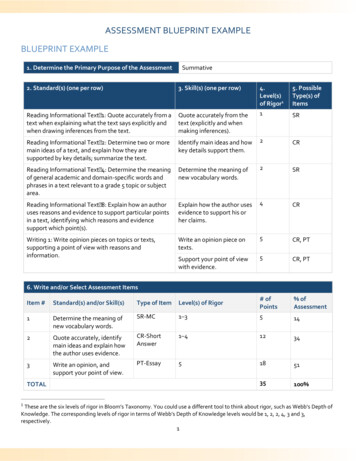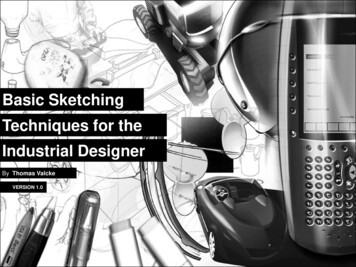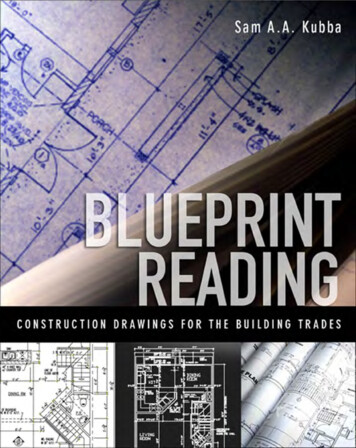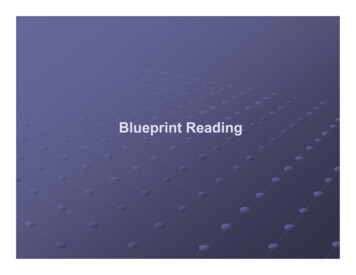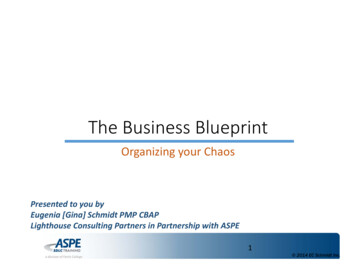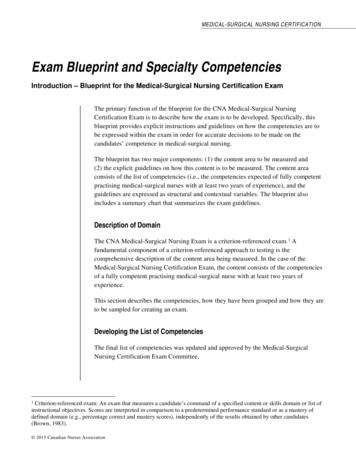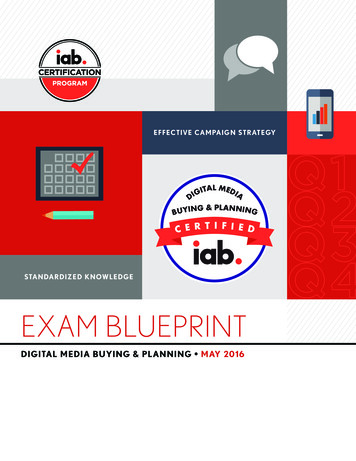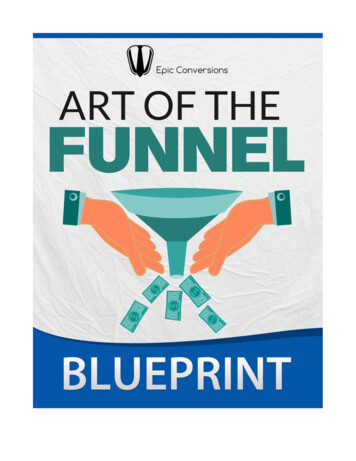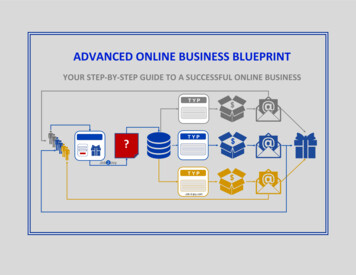
Transcription
NONRESIDENTTRAININGCOURSEMay 1994Blueprint Readingand SketchingNAVEDTRA 14040DISTRIBUTION STATEMENT A: Approved for public release; distribution is unlimited.
Although the words “he,” “him,” and“his” are used sparingly in this course toenhance communication, they are notintended to be gender driven or to affront ordiscriminate against anyone.DISTRIBUTION STATEMENT A: Approved for public release; distribution is unlimited.
COMMANDING OFFICERNETPDTC6490 SAUFLEY FIELD RDPENSACOLA, FL 32509-5237ERRATA #119 Oct 1998Specific Instructions and Errata forNonresident Training CourseBLUEPRINT READING AND SKETCHING1. No attempt has been made to issue corrections for errorsin typing, punctuation, etc., that do not affect yourability to answer the question or questions.2. To receive credit for deleted questions, show thiserrata to your local course administrator (ESO/scorer).The local course administrator is directed to correct thecourse and the answer key by indicating the questiondeleted.3.Assignment BookletDelete the following questions, and leave the correspondingspaces blank on the answer sheets:Questions1-211-222-483-284-214-344-62
PREFACEBy enrolling in this self-study course, you have demonstrated a desire to improve yourself and the Navy.Remember, however, this self-study course is only one part of the total Navy training program. Practicalexperience, schools, selected reading, and your desire to succeed are also necessary to successfully roundout a fully meaningful training program.COURSE OVERVIEW: Upon completing this nonresident training course, you should understand thebasics of blueprint reading including projections and views, technical sketching, and the use of blueprints inthe construction of machines, piping, electrical and electronic systems, architecture, structural steel, andsheet metal.THE COURSE: This self-study course is organized into subject matter areas, each containing learningobjectives to help you determine what you should learn along with text and illustrations to help youunderstand the information. The subject matter reflects day-to-day requirements and experiences ofpersonnel in the rating or skill area. It also reflects guidance provided by Enlisted Community Managers(ECMs) and other senior personnel, technical references, instructions, etc., and either the occupational ornaval standards, which are listed in the Manual of Navy Enlisted Manpower Personnel Classificationsand Occupational Standards, NAVPERS 18068.THE QUESTIONS: The questions that appear in this course are designed to help you understand thematerial in the text.VALUE: In completing this course, you will improve your military and professional knowledge.Importantly, it can also help you study for the Navy-wide advancement in rate examination. If you arestudying and discover a reference in the text to another publication for further information, look it up.1994 Edition Prepared byMMC(SW) D. S. GundersonPublished byNAVAL EDUCATION AND TRAININGPROFESSIONAL DEVELOPMENTAND TECHNOLOGY CENTERNAVSUP Logistics Tracking Number0504-LP-026-7150i
Sailor’s Creed“I am a United States Sailor.I will support and defend theConstitution of the United States ofAmerica and I will obey the ordersof those appointed over me.I represent the fighting spirit of theNavy and those who have gonebefore me to defend freedom anddemocracy around the world.I proudly serve my country’s Navycombat team with honor, courageand commitment.I am committed to excellence andthe fair treatment of all.”ii
CONTENTSPAGECHAPTER1. Blueprint Reading. . . . . . . . . . . . . . . . . . . . . . . . . . 1-12. Technical Sketching3. Projections and Views. . . . . . . . . . . . . . . . . . . . . . . . . 2-1. . . . . . . . . . . . . . . . . . . . . . . . 3-14. Machine Drawings . . . . . . . . . . . . . . . . . . . . . . . . . . 4-15. Piping Systems . . . . . . . . . . . . . . . . . . . . . . . . . . . 5-16. Electrical and Electronics Prints . . . . . . . . . . . . . . . . . . . 6-17. Architectural and Structural Steel Drawings . . . . . . . . . . . . . 7-18. Developments and Intersections . . . . . . . . . . . . . . . . . . . 8-1APPENDIXI. Glossary . . . . . . . . . . . . . . . . . . . . . . . . . . . . . . . AI-1II. Graphic Symbols for Aircraft Hydraulic andPneumatic Systems . . . . . . . . . . . . . . . . . . . . . . . . AII-1III. Graphic Symbols for Electrical and Electronics Diagrams. . . AIII-1IV.Deleted. . . . . . . . . . . . . . . . . . . . . . . . . . . .AIV-1V. References Used to Develop the TRAMAN . . . . . . . . . . . . AV-1INDEX . . . . . . . . . . . . . . . . . . . . . . . . . . . . . . . . . . INDEX-1iii
INSTRUCTIONS FOR TAKING THE COURSEassignments. To submit youranswers via the Internet, go to:ASSIGNMENTSThe text pages that you are to study are listed atthe beginning of each assignment. Study thesepages carefully before attempting to answer thequestions. Pay close attention to tables andillustrations and read the learning objectives.The learning objectives state what you should beable to do after studying the material. Answeringthe questions correctly helps you accomplish theobjectives.http://courses.cnet.navy.milGrading by Mail: When you submit answersheets by mail, send all of your assignments atone time. Do NOT submit individual answersheets for grading. Mail all of your assignmentsin an envelope, which you either provideyourself or obtain from your nearest EducationalServices Officer (ESO). Submit answer sheetsto:SELECTING YOUR ANSWERSCOMMANDING OFFICERNETPDTC N3316490 SAUFLEY FIELD ROADPENSACOLA FL 32559-5000Read each question carefully, then select theBEST answer. You may refer freely to the text.The answers must be the result of your ownwork and decisions. You are prohibited fromreferring to or copying the answers of others andfrom giving answers to anyone else taking thecourse.Answer Sheets: All courses include one“scannable” answer sheet for each assignment.These answer sheets are preprinted with yourSSN, name, assignment number, and coursenumber. Explanations for completing the answersheets are on the answer sheet.SUBMITTING YOUR ASSIGNMENTSTo have your assignments graded, you must beenrolled in the course with the NonresidentTraining Course Administration Branch at theNaval Education and Training ). Following enrollment, there aretwo ways of having your assignments graded:(1) use the Internet to submit your assignmentsas you complete them, or (2) send all theassignments at one time by mail to NETPDTC.Grading on the Internet:Internet grading are: assignmentDo not use answer sheet reproductions: Useonly the original answer sheets that weprovide—reproductions will not work with ourscanning equipment and cannot be processed.Follow the instructions for marking youranswers on the answer sheet. Be sure that blocks1, 2, and 3 are filled in correctly. Thisinformation is necessary for your course to beproperly processed and for you to receive creditfor your work.Advantages toCOMPLETION TIMEyou may submit your answers as soon asyou complete an assignment, andyou get your results faster; usually by thenext working day (approximately 24 hours).Courses must be completed within 12 monthsfrom the date of enrollment. This includes timerequired to resubmit failed assignments.In addition to receiving grade results for eachassignment, you will receive course completionconfirmation once you have completed all theiv
PASS/FAIL ASSIGNMENT PROCEDURESFor subject matter questions:If your overall course score is 3.2 or higher, youwill pass the course and will not be required toresubmit assignments. Once your assignmentshave been graded you will receive coursecompletion milComm: (850) 452-1001, Ext. 1826DSN: 922-1001, Ext. 1826FAX: (850) 452-1370(Do not fax answer sheets.)Address: COMMANDING OFFICERNETPDTC N3146490 SAUFLEY FIELD ROADPENSACOLA FL 32509-5237If you receive less than a 3.2 on any assignmentand your overall course score is below 3.2, youwill be given the opportunity to resubmit failedassignments. You may resubmit failedassignments only once. Internet students willreceive notification when they have failed anassignment--they may then resubmit failedassignments on the web site. Internet studentsmay view and print results for failedassignments from the web site. Students whosubmit by mail will receive a failing result letterand a new answer sheet for resubmission of eachfailed assignment.For enrollment, shipping,completion letter .navy.milToll Free: 877-264-8583Comm: (850) 452-1511/1181/1859DSN: 922-1511/1181/1859FAX: (850) 452-1370(Do not fax answer sheets.)Address: COMMANDING OFFICERNETPDTC N3316490 SAUFLEY FIELD ROADPENSACOLA FL 32559-5000COMPLETION CONFIRMATIONAfter successfully completing this course, youwill receive a letter of completion.NAVAL RESERVE RETIREMENT CREDITERRATAIf you are a member of the Naval Reserve,you may earn retirement points for successfullycompleting this course, if authorized undercurrent directives governing retirement of NavalReserve personnel. For Naval Reserve retirement, this course is evaluated at 6 points. (Referto Administrative Procedures for NavalReservists on Inactive Duty, BUPERSINST1001.39, for more information about retirementpoints.)Errata are used to correct minor errors or deleteobsolete information in a course. Errata mayalso be used to provide instructions to thestudent. If a course has an errata, it will beincluded as the first page(s) after the front cover.Errata for all courses can be accessed andviewed/downloaded at:http://www.advancement.cnet.navy.milSTUDENT FEEDBACK QUESTIONSWe value your suggestions, questions, andcriticisms on our courses. If you would like tocommunicate with us regarding this course, weencourage you, if possible, to use e-mail. If youwrite or fax, please use a copy of the StudentComment form that follows this page.v
Student CommentsCourse Title:Blueprint Reading and SketchingNAVEDTRA:14040Date:We need some information about you:Rate/Rank and Name:SSN:Command/UnitStreet Address:City:State/FPO:ZipYour comments, suggestions, etc.:Privacy Act Statement: Under authority of Title 5, USC 301, information regarding your military status isrequested in processing your comments and in preparing a reply. This information will not be divulged withoutwritten authorization to anyone other than those within DOD for official use in determining performance.NETPDTC 1550/41 (Rev 4-00vii
CHAPTER 1BLUEPRINTSAnother type of duplicating process rarely used toreproduce working drawings is the photostatic processin which a large camera reduces or enlarges a tracingor drawing. The photostat has white lines on a darkbackground. Businesses use this process to incorporate reduced-size drawings into reports or records.When you have read and understood this chapter,you should be able to answer the following learningobjectives:Describe blueprints and how they are produced.Identify the information contained in blueprints.The standards and procedures prescribed formilitary drawings and blueprints are stated in militarystandards (MIL-STD) and American National Standards Institute (ANSI) standards. The Department ofDefense Index of Specifications and Standards liststhese standards; it is issued on 31 July of each year.The following list contains common MIL-STD andANSI standards, listed by number and title, thatconcern engineering drawings and blueprints.Explain the proper filing of blueprints.Blueprints (prints) are copies of mechanical orother types of technical drawings. The term blueprintreading, means interpreting ideas expressed by otherson drawings, whether or not the drawings are actuallyblueprints. Drawing or sketching is the universallanguage used by engineers, technicians, and skilledcraftsmen. Drawings need to convey all the necessaryinformation to the person who will make or assemblethe object in the drawing. Blueprints show theconstruction details of parts, machines, ships, aircraft,buildings, bridges, roads, and so forth.TitleNumberMIL-STD-100AEngineering Drawing PracticesANSI Y14.5M-1982Dimensioning and TolerancingMIL-STD-9AScrew Thread Conventions andMethods of SpecifyingANSI 46.1-1962Surface TextureBLUEPRINT PRODUCTIONMIL-STD-12CAbbreviations for Use on DrawingsOriginal drawings are drawn, or traced, directly ontranslucent tracing paper or cloth, using black waterproof India ink, a pencil, or computer aided drafting(CAD) systems. The original drawing is a tracing or“master copy.” These copies are rarely, if ever, sent toa shop or site. Instead, copies of the tracings are givento persons or offices where needed. Tracings that areproperly handled and stored will last indefinitely.MIL-STD-14AArchitectural SymbolsANSI Y32.2Graphic Symbols for Electrical andElectronic DiagramsMIL-STD-15Electrical Wiring Part 2, and Equipment Symbols for Ships and Plans,Part 2ANSI Y32.9Electrical Wiring Symbols forArchitectural and Electrical LayoutDrawingsMIL-STD-16CElectrical and Electronic ReferenceDesignationsMIL-STD-17B, Part 1Mechanical SymbolsMIL-STD-17B, Part 2Mechanical Symbols for Aeronautical,Aerospace craft and Spacecraft useMIL-STD-18BStructural SymbolsMIL-STD-21AWelded-Joint Designs, Armored-TankTypeWelded Joint DesignsThe term blueprint is used loosely to describecopies of original drawings or tracings. One of the firstprocesses developed to duplicate tracings producedwhite lines on a blue background; hence the termblueprint. Today, however, other methods produceprints of different colors. The colors may be brown,black, gray, or maroon. The differences are in thetypes of paper and developing processes used.A patented paper identified as BW paper producesprints with black lines on a white background. Thediazo, or ammonia process, produces prints with eitherblack, blue, or maroon lines on a white background.MIL-STD-22AMIL-STD-25A1-1Nomenclature and Symbols for ShipSt
blueprint. Today, however, other methods produce prints of different colors. The colors may be brown, black, gray, or maroon. The differences are in the types of paper and developing processes used. A patented paper identified as BW paper produces prints with black lines on a white background. The diazo, or ammonia process, produces prints with either black, blue, or maroon lines on a white .
